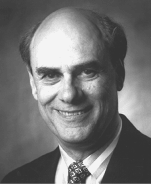 |
News
Volume 13, Number 4 (November, 1998) (November, 1998) |
NIDA's Division of Intramural Research Broadens its Neuroscience Focus
By Sharon Cargo, NIDA NOTES Contributing Writer
The Division of Intramural Research (DIR) at NIDA's Addiction Research Center in Baltimore has augmented its neuroscience research activities with the addition of two new research branches - the Behavioral Neuroscience Branch (BNB) and the Cellular Neurobiology Branch (CNB).
 BNB researchers study how the brain responds to the addictive properties of commonly abused drugs. Heading this branch is Dr. Roy A. Wise(left), a veteran neuroscientist whose career has focused on researching the effects of drugs on the brains of animals to better understand their effects on the human brain. While teaching and conducting research at Concordia University in Montreal, Canada, Dr. Wise developed a research program on the brain's drug-reward mechanisms that received support in part from NIDA. Dr. Wise has authored more than 150 publications and is a member of the Academy of Science of the Royal Society of Canada.
BNB researchers study how the brain responds to the addictive properties of commonly abused drugs. Heading this branch is Dr. Roy A. Wise(left), a veteran neuroscientist whose career has focused on researching the effects of drugs on the brains of animals to better understand their effects on the human brain. While teaching and conducting research at Concordia University in Montreal, Canada, Dr. Wise developed a research program on the brain's drug-reward mechanisms that received support in part from NIDA. Dr. Wise has authored more than 150 publications and is a member of the Academy of Science of the Royal Society of Canada.
Under Dr. Wise's leadership, BNB scientists conduct research on the areas of the brain where drugs of abuse, particularly stimulants and opiates, are believed to initiate their addictive effects. They use normal and genetically altered rodents to help identify the pathways in the brain through which drugs work. Other areas of research include studies of drug-induced convulsions and brain cell damage, the complications of drug addiction, and the development of medications to treat addiction.
 CNB investigates the effects of abused drugs on nerve cells, including addiction, cell damage, reinforcement, and the adaptive changes that occur in the brain with chronic drug use. Dr. William J. Freed (right), another seasoned neuroscientist, is directing the new branch after working for more than 20 years at the National Institute of Mental Health (NIMH). For 14 years, Dr. Freed served as chief of NIMH's Preclinical Neurosciences Research Section at St. Elizabeth's Hospital in Washington, D.C. He has just completed a term as president of the American Society for Neural Transplantation and Plasticity and is editor of the Cellular and Molecular Neuroscience Section of Experimental Neurology. CNB investigates the effects of abused drugs on nerve cells, including addiction, cell damage, reinforcement, and the adaptive changes that occur in the brain with chronic drug use. Dr. William J. Freed (right), another seasoned neuroscientist, is directing the new branch after working for more than 20 years at the National Institute of Mental Health (NIMH). For 14 years, Dr. Freed served as chief of NIMH's Preclinical Neurosciences Research Section at St. Elizabeth's Hospital in Washington, D.C. He has just completed a term as president of the American Society for Neural Transplantation and Plasticity and is editor of the Cellular and Molecular Neuroscience Section of Experimental Neurology.
Researchers in CNB study topics such as:
- neural plasticity - the tendency of nerve cells to alter or conform to environmental influences;
- the physiological properties of tissues and cells that are affected by dopamine, a brain chemical associated with feelings of pleasure and responsible for many of the euphoric effects of drugs;
- techniques that scientists can use to design cellular models for investigating the effects of drugs;
- the effects of drug treatments and neuropsychiatric disorders on various types of molecules that are important to the functioning of nerve and glial cells;
- how methamphetamine and other commonly abused drugs damage brain and nervous system cells; and
- the role of opioids that occur naturally in the body and how they protect against the toxic effects of drugs.
|
NIDA NOTES - Volume 13, Number 4 |
[NIDA Home Page][Site Index][NIDA NOTES Index][Index of this Issue]
|